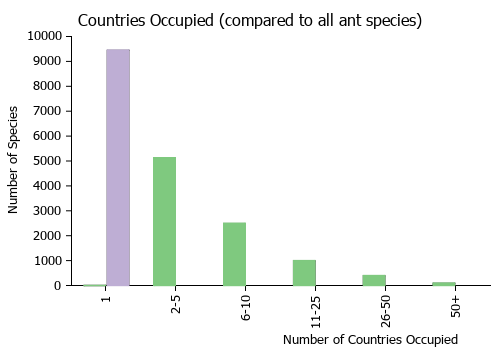Adelomyrmex quetzal
| Adelomyrmex quetzal | |
|---|---|

| |
| Scientific classification | |
| Kingdom: | Animalia |
| Phylum: | Arthropoda |
| Class: | Insecta |
| Order: | Hymenoptera |
| Family: | Formicidae |
| Subfamily: | Myrmicinae |
| Tribe: | Solenopsidini |
| Genus: | Adelomyrmex |
| Species: | A. quetzal |
| Binomial name | |
| Adelomyrmex quetzal Longino, 2012 | |
This species occurs in cloud forest, from 1550–1750 m elevation. It is known from ten different Winkler samples of sifted litter, from two regions of Guatemala.
Identification
Longino (2012) - Mandible lacking differentiated basal and masticatory margins; counting from apex, fifth tooth closer to sixth (basal) tooth than to fourth tooth; scape lacking long erect setae projecting above underlying pubescence; gaster dark red brown, concolorous with rest of body (gaster contrastingly yellow in the similar Adelomyrmex mackayi); metanotal groove not impressed (impressed in A. mackayi).
Keys including this Species
Distribution
Latitudinal Distribution Pattern
Latitudinal Range: 15.226° to 15.1989°.
| North Temperate |
North Subtropical |
Tropical | South Subtropical |
South Temperate |
- Source: AntMaps
Distribution based on Regional Taxon Lists
Neotropical Region: Guatemala (type locality).
Distribution based on AntMaps
Distribution based on AntWeb specimens
Check data from AntWeb
Countries Occupied
| Number of countries occupied by this species based on AntWiki Regional Taxon Lists. In general, fewer countries occupied indicates a narrower range, while more countries indicates a more widespread species. |

|
Estimated Abundance
| Relative abundance based on number of AntMaps records per species (this species within the purple bar). Fewer records (to the left) indicates a less abundant/encountered species while more records (to the right) indicates more abundant/encountered species. |

|
Biology
Castes
Images from AntWeb

| |
| Paratype Adelomyrmex quetzal. Worker. Specimen code casent0627819. Photographer Jeremy Pilllow, uploaded by University of Utah. | Owned by MCZC. |
Nomenclature
The following information is derived from Barry Bolton's Online Catalogue of the Ants of the World.
- quetzal. Adelomyrmex quetzal Longino, 2012: 28, figs. 20, 21 (w.) GUATEMALA.
- Type-material: holotype worker, paratype workers (number not stated; at least 12).
- Type-locality: holotype Guatemala: Baja Verapaz, Biotopo Quetzal, 15.21224, -90.21421±50m., 1750 m., 7.v.2009, LLAMA Wa-B-02-1-39 (no collector’s name); paratypes: Baja Verapaz, 4.5 km. S Purulha, 1630 m., 21.v.1991, 91-006 (R.S. Anderson), as last but 24.v.1991, 91-019 (R.S. Anderson), 7.5 km. S Purulha, 1630 m., 26.v.1991, 91-026 (R.S. Anderson).
- Type-depositories: CASC (holotype); BMNH, CFSS, EAPZ, ICNB, INBC, LACM, MCZC, MZSP, UCDC, UNAM, USNM, UVGC (paratypes).
- Distribution: Guatemala.
Unless otherwise noted the text for the remainder of this section is reported from the publication that includes the original description.
Description
Worker
HW 0.67–0.71 (n=6); mandible without differentiated masticatory and basal margins, with six distinct teeth distributed from apex to base, fifth tooth closer to sixth (basal) tooth than to fourth tooth, and with a deep notch between sixth tooth and basal condyle; dorsal surface of mandible with several coarse longitudinal striae and several large piligerous puncta; in full face view, lateral clypeal teeth project from beneath clypeal shelf; lateral clypeal teeth located on anterior (ventral) margin of clypeus and separate from transverse carina that forms clypeal shelf; hypostomal tooth absent; compound eye composed of 11–13 ommatidia; face fully sculptured with longitudinal rugae.
Short anterior face of pronotum well separated from dorsal face by an elevated transverse ruga; dorsal profile of promesonotum and propodeum forming a single arched convexity, metanotal groove not impressed; propodeal spines pronounced, acute; space between propodeal spines a broad concavity without distinct dorsal and posterior faces, smooth and shiny with a few transverse rugae; rest of mesosoma with strong, linear, longitudinal rugae; petiolar and postpetiolar nodes subquadrate with differentiated anterior, dorsal, and posterior faces; petiole and postpetiole coarsely irregularly rugose laterally, transversely rugose dorsally; postpetiole in dorsal view about as long as wide to slightly longer than wide, with straight anterior margin and evenly rounded posterior margin; gastral dorsum smooth and shining.
Scape with abundant long subdecumbent pubescence; clypeus and frontal carinae with long erect setae; posterior and posterolateral margins of head with long erect setae; mid and hind tibia with abundant long subdecumbent setae and 2–3 differentiated erect setae that are longer than width of tibia; in profile, dorsal surfaces of head, mesosoma, and gaster with relatively sparse, long, erect setae; FSH about 0.08, FSI 0.11.
Color dark red brown.
Type Material
Holotype worker. Guatemala, Baja Verapaz: Biotopo Quetzal, 15.21224 −90.21421 ±50 m, 1750 m, 7 May 2009 (LLAMA Wa-B-02-1-39) [CAS, unique specimen identifier CASENT0614520]. Paratypes (workers): Guatemala, Baja Verapaz: 4.5km S Purulha, 15.226 −90.2 ±10 km, 1630 m, 21 May 1991 (R. S. Anderson 91-006) [ICN, CASENT0604444], [INBIO, CASENT0604450], [UCD, CASENT0604453], [UNAM, CASENT0604443]; same data but 24 May 1991 (R. S. Anderson 91-019) [LACM, CASENT0603653], [UVGC, CASENT0603652]; 7.5km S Purulha, 15.2 −90.2 ±12 km, 1630 m, 26 May 1991 (R. S. Anderson 91-026) [BMNH, CASENT0601496], [EAPZ, CASENT0601501], [ECOSCE, CASENT0601495], [MCZC, CASENT0627819], [MZSP, CASENT0627816], [USNM, CASENT0627815].
Etymology
Referring to the type locality.
References
- Longino, J.T. 2012. A review of the ant genus Adelomyrmex Emery 1897 (Hymenoptera, Formicidae) in Central America. Zootaxa 3456, 1–35.
References based on Global Ant Biodiversity Informatics
- Longino J. T. 2012. A review of the ant genus Adelomyrmex Emery 1897 (Hymenoptera, Formicidae) in Central America. Zootaxa 3456: 1-35

